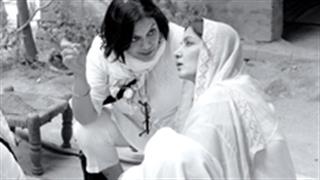She has been a single mother for most of her life. But she is also famous, successful and rich in the cut-throat, male-dominated world of Indian cinema. That is Saroj Khan, Bollywoods's prima donna of choreography which Nidhi Tuli's 57-minute celluloid tribute The Saroj Khan Story profiles.
Never before in the history of Indian cinema has a tribute been paid to a choreographer in a documentary form.
Khan emerged as child artist with exceptional dancing talent from a humble beginning in the early 1950s.
Eventually she was present, in each decade of Hindi cinema, first as a background dancer, then as an assistant teaching intricate steps to heroines, from Vyjyanthimala to twinkle-toed Madhuri Dixit. The legendary choreographer continued to the next generation stars like Aishwarya Rai, Kareena Kapoor and Sonakshi Sinha.
`The Saroj Khan Story began as a search for the genius behind one of the greatest choreographers Indian cinema has ever produced. What surfaces is a deeply personal story of determination, passion, extraordinary skill and the sheer will to survive that is both intimate and inspiring, ` reveals director Tuli, adding, `I was a fan like most people who know about her choreography, but it was during the making of the film that I discovered that she's a genius but wears it lightly. She is a perfectionist and a very passionate dancer.`
Tuli did her Masters in feature film screenwriting from the Royal Holloway, University of London, under the Charles Wallace India trust scholarship.
While in UK she won the Raindance film pitch competition at the Edinburgh Film Festival, 2004. She produced and directed the documentary Ladies Special that bagged the John Abraham National Award in 2005 and the 'George Ragot love the train' award at the Cine Rail Paris in 2009. Her other films include Art in Exile, TIPA, Of Friendship, Films and Swords and The Saint of Chitrakoot.
The film focuses on Saroj Khan narrating her slow rise in filmdom from a chorus dancer in the back row. The film opens with Khan in her car, talking into her cell-phone till it cuts to a close-up of the lady at home with walls filled with photographs and portraits of herself and family members.
She looks back wistfully to her past that includes episodes on the perpetual sickness of a daughter who passed away later. But Khan refuses to be bogged down by the tragedy; neither does she seek sympathy from others.

`It has been a long struggle with many ups and downs in my personal life. The dances I compose and direct don't show the tears and the heartbreaks in my life, ` Khan says. She was betrayed in love by her mentor and guru who left her when she became pregnant. She carried the emotional, financial and professional burden singly on her bold shoulders and continues to do so till today.
Khan's repertoire of having choreographed in more than 200 films ranges from the purely classical numbers in the Tamil film Shringaram - Dance of Love (2005), the graceful numbers executed by Aishwarya Rai in Subhash Ghai's Taal, to the sizzling duet performed by the lead pair in Rowdy Rathore (2012).
Shringaram was directed by noted dancer Saradha Ramanathan, produced by Padmini Ravi, a classical dancer and was a period film set in the 19th Century on the life of a devadasi. Aditi Rao Hydari, a talented Bharat Natyam dancer, played the lead role.
Though the producer and director were both celebrated dancers, they chose Saroj Khan for the choreography. She won the National Award for Best Choreography, one of her string of three national awards.
Tuli says that the idea of making a film on Khan struck her after seeing her on the dance reality show Nach Baliye in 2007/08. She was a judge on the show. `When a couple danced on the Madhumati number, daiya re daiya chad gaya paapi bichua, she said `jab yeh gaana filmaya ja raha tha tab main peechay dancer thi` (when this song umber was getting filmed I was in the background). The words stayed with me. My immediate thought was, this legendary choreographer was once a background dancer and wished to explore the journey that brought her where she is today, ` she says.

When Tuli approached Khan she agreed instantly but without showing any excitement. `I realised that it didn't really matter to her whether I make the film on her or not. She is at a point in her life where she doesn't expect anything from anyone (as she says in the film). She didn't think my film would benefit her or harm her. She was fine either way, ` sums up Tuli. This spirit carries over in the film.
Reminiscing over some of the numbers she has choreographed, Khan reveals, `The Madhuri Dixit number on the song maar dala in Sanjay Leela Bhansali's Devdas (2002) had the refrain maar dala four times in each stanza. I convinced and taught Madhuri to execute the refrain differently each time.
And she expressed this beautifully.` This choreography got for Khan the National Award preceded by another National Award for the dance numbers in Hemant Gowarikar's Lagaan (2001) alongside the Filmfare Award. One similar milestone is Bhansali's Hum Dil De Chuke Sanam which brought her a string of awards which also got her the Best American Choreography Award.
And the work goes on.


















